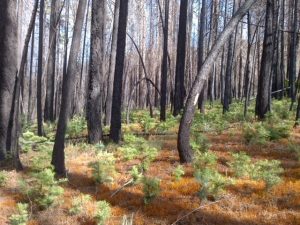Thanksgiving is almost upon us. A rafter of wild turkeys waddled through my garden and disappeared into the forest. The trees have burst into colors of orange, red, gold and brown. It is time to decorate our porches and tables with pumpkins, gourds and autumn leaves to create a cornucopia of food and decor representing the harvest. We can hardly wait to sink our teeth into a juicy turkey with cranberry sauce and sit around the table with friends and family.
But we rarely give real thanks for all the things we have up here in the foothills and mountains of the Sierra. Nature’s bounty is all around us. The hills surrounding Sonora come alive with color in the fall. The leaves of our native dogwoods turn mottled pink and reddish-brown and drift slowly to the ground as the trees close down for the year. The crape myrtles explode into neon yellows and oranges, as if the trees had burst into flames.
Rather than just looking at all this bounty from afar, why not go out into the forest and fields and experience it first hand? To be really thankful, you need to experience the smells and feel of the forest and fields around us. In her book, “Braiding Sweetgrass,” Robin Wall Kimmerer says, “As if harvest time were not enough – peaches, grapes, sweet corn, squash – the fields are also embroidered with drifts of golden yellow and pools of deepest purple, a masterpiece.”
We have so much to be thankful for. Instead of mourning the loss of all the pine trees to the bark beetle, we should be thankful for the pines that have survived. They are the strong ones that will be pollinated and produce stronger, more drought-tolerant saplings. We should be thankful that the regrowth after the Rim fire is lush and the recovery is astounding. At the base of blackened oaks and pines, bright green shoots are growing out of the ashes. Wildflowers carpeted the floor of the forest last Spring, making a startling display of regrowth and color.
Gratitude and giving thanks has always been a daily ritual for Native Americans. The Native Americans of the East Coast shared their food, knowledge and skills with the colonists. These gifts allowed the colonists to survive their first winter in their new environment and enabled them to produce some of the harvest that contributed to this first Thanksgiving feast.
Kimmerer (a member of the Citizen Potawatomi Nation), tells of a prayer of gratitude recited daily by the children of the Onondaga Nation in their school: “Today we have gathered and when we look upon the faces around us we see that the cycles of life continue. We have been given the duty to live in balance and harmony with each other and all living things. So now let us bring our minds together as one as we give greetings and thanks to each other as People. Now our minds are one.” In our commercial world, it is easy to forget about our natural environment and our debt to it.
As we sit down to dinner this coming Thursday and give the usual thanks for the food in front of us, let’s be mindful of the bounty of the Sierra Nevada and all the wonders it holds and pledge to be good stewards of this beautiful forest.
Happy Thanksgiving!
Francie McGowan is a University of California Cooperative Extension Master Gardener of Tuolumne County.
Photos by the National Audubon Society and the John Muir Project



